![]() 1st Battalion 22nd Infantry
1st Battalion 22nd Infantry ![]()
George A. Finley
Six years with the 22nd Infantry
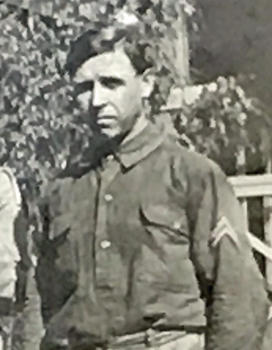
George A. Finley was born in
Grogey, Fermanagh, Ireland on May 22, 1879, the son of George and
Elizabeth Finlay. He immigrated with his family to the United
States in September 1885, arriving in
Philadelphia, Pennsylvania. At some point the family name was
changed to Finley. Prior to entering
the Army Finley was employed as an ironworker in Pennsylvania.
When he was nineteen years old
Finley lied about his age, in order to enlist in the Army. (At
the time, the minimum age
for enlistment was twenty-one.) He entered the Army on November
28, 1898 at Cleveland, Ohio. He was assigned
as a Private, to Company I 22nd Infantry at Fort Crook, Nebraska
on December 1, 1898.
He stood five feet five and a
half inches tall, had light brown hair,
grey eyes and a fair complexion.
Finley sailed to the Philippines
with Company I aboard the transport Ohio, leaving San
Francisco on February 1, 1899
and arriving at Manila on March 5, 1899. He went into his first
action on March 13, in the Pasig Expedition. His next
action was in the Malolos Expedition. On March 24, 1899, the 22nd
Infantry, under command by Colonel Harry Egbert,
as part of the Brigade led by Brigadier General Lloyd Wheaton,
advanced northward from Manila, past Caloocan and Malabon,
and approached the outskirts of the village of Malinta. On March
26 Finley and a Corporal named O'Brien were detailed to
climb up a hill forward of Company I's position, and scout for
the enemy.
1st Lieutenant William A.
Campbell, commanding Company I, in his After Action Report to his
Battalion Commander,
Major John G. Ballance, described the action. The scouts
mentioned in his report were Finley and O'Brien:
"When within about 800
yards of the enemy the company was halted by your command and
scouts were sent forward to a
small knoll about 300 yards to the front. They reported that
several of the enemy were sitting on their intrenchments about
500 yards in advance, but that some appeared to be moving to the
right. After waiting for some minutes for orders to advance,
fire was opened upon us by the enemy and I suddenly heard the
charge being sounded and saw a company
about 200 yards in my rear advancing in double time. I
immediately ordered the company forward in double time
and on reaching the crest of the knoll in front began firing at
the enemy, who were behind intrenchments about 500 yards
in front. After firing five or six rounds the signal to cease
firing was given and the order to charge repeated. Bv this time
Company L had intermixed with Company I and the whole line
advanced, the enemy leaving the intrenchments and
taking up a position behind a stone wall inclosing an old church,
and behind some rice mounds on the right of the railroad.
Upon reaching the enemy's intrenchments the company halted with
the others and after a few individual shots began firing
volleys at the stone wall and rice bank about 500 yards
distant." 1
The actions of Finley and
O'Brien that day were related in an article in the Times of
Cuba and -- P.A.R. -- Pan-American Review
in 1941. In the article Finley's name is spelled Finlay:
"...GEORGE
FINLAY, who with the present writer was acclaimed hero in 1898 [sic] when they
volunteered on this same
battlefield to go up Malinta Hill and locate the (then) enemy. Finlay and
O'Brien were private and corporal in Co. I, 22nd
U.S. Infantry, and had lain thirstily in the broiling sun at the
foot of the Caloocan hill after dumping the water from their
canteens in favor of water (it proved salty) from a nearby stream
they had just waded in a flanking maneuver. One doughboy
carrying on his shoulders, the regiment's beloved commander,
General Egbert, who little realized he was to be killed the same
day.
Finlay and O'Brien stuck their more or less Irish heads above the
top of the hill in time to be welcomed by a volley from
the Filipinos (then known as 'gugus') from their trench just
ahead. There were several casualties in the rear coincident with
ensuing volleys and the return of Finlay and O'Brien. Who both
rolled incontinently back to the place from whence they came.
With no thought of heroism whatsoever. In fact, the writer (who
cannot vouch for Finlay's motives) was imbued solely by a
desire to get away from the hornets at the top of the hill just
as expeditiously as possible. He had formed a part of the twosome
merely because he realized that green troops invariably shoot
high and that safety was ahead rather than in the rear. General
Egbert lost his life in the charge that ensued, the surprised
Filipinos fleeing precipitately to more remote cover when the
Americans arrived and spattering Krag bullets joined the shrill
Mauser concatenation. The writer was later recommended
for a commission for his part in the melee but neither of the two
participants either expected or received honor or reward
for their foolhardiness" 2
Malinta was taken, and Finley
and Company I continued on, and with the rest of the Regiment
took Malolos
on March 31, 1899. Finley then served in the San Isidro Campaign.
At an unknown date he was promoted to Corporal.
In May 1900 Finley was part of a
detachment of twenty men from Company I, being led by Lieutenant
Paul Draper,
operating a few miles northwest of the village of San Antonio,
and quite near the village of Santa Barbara. The Regimental
history indicates that on May 9, 1900 Draper's detachment
"struck a band of insurgents near barrio Santa Barbara;
killed three, wounded four, captured twenty-nine rifles, 886
rounds of ammunition, and one horse. No casualties."
On May 18, 1925 the War
Department awarded George Finley a Silver Star Citation for his
actions on May 9, 1900,
as a Corporal and part of Lieutenant Draper's detachment in that
skirmish near San Antonio, Ecija Province.
Unfortunately, the citation describing the individual actions he
performed to earn the award could not be found.
After 1932 recipients of such Citations were allowed to have
their awards converted to a Silver Star Medal.
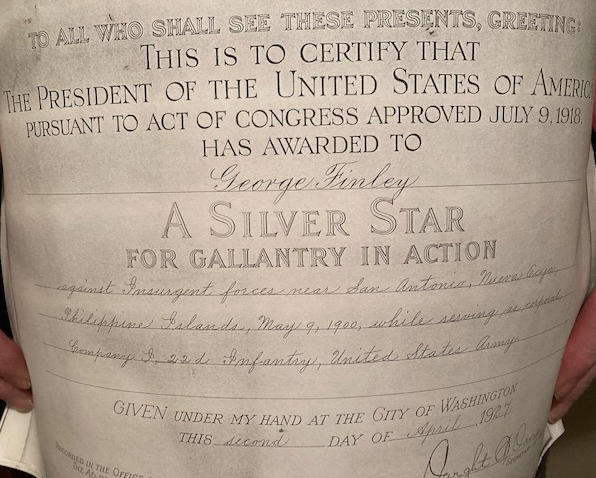
Above: The Silver Star Citation
certificate issued to Corporal George Finley
for gallantry in action as part of Lt. Draper's detachment from
Company I 22nd Infantry
during the skirmish of May 9, 1900. Though the issue date of the
certificate is April 2, 1927,
the War Department orders issuing the award are dated May 18,
1925.
Photo courtesy of The Finley Family
In July of 1900 Finley was part
of Brigadier General Frederick Funston's expedition in the area
around Mount Corona, on the Island of Luzon. Funston's column,
which consisted of Companies
of the 22nd Infantry, 34th Infantry, and a troop of the 4th
Cavalry, located and attacked an insurgent
stronghold, and drove the enemy deeper into the mountains.
For the better part of 1901
Finley and Company I were stationed at San Antonio, and carried
out patrols
in the nearby villages and mountains, searching for and
destroying insurgent caches and disrupting the
enemy's activities. During the latter part of 1901 Finley was
reduced to the rank of Private.
Finley was discharged at Manila
on November 27, 1901, with a character reference of Very Good.
After a month's leave
in the Philippines, he re-enlisted in Company I 22nd Infantry at
Manila on January 7, 1902. He returned to the United States
with his Company aboard the transport Rosencrans,
leaving Manila on January 24, 1902 and arriving at San Francisco,
California on February 25, 1902. On March 11 his Company returned
to Fort Crook, Nebraska, where they would be stationed
until their next deployment.
On July 27, 1902 Finley was one
of two soldiers from Company I detailed to become a part of the
Regimental rifle team,
for the Department of the Missouri Infantry competition at Fort
Leavenworth, Kansas. The 22nd Infantry rifle team
won first place in the competition, and then second place in the
Army-wide competition held at Fort Sheridan, Illinois.
In September 1902 Finley was
part of the 22nd Infantry contingent taking part in the large
Army maneuvers held near
Fort Riley, Kansas. Part of the exercise was a long foot march
undertaken by two Battalions of the 22nd Infantry,
from Fort Crook to Fort Riley, a distance of about 200 miles. It
took Finley and his fellow soldiers about fourteen days
to complete this march.
On April 28, 1903 Finley and his
Company, as part of two Battalions of the 22nd Infantry, marched
in the big parade in
St. Louis, Missouri, coincidental to the opening and dedication
of the Louisiana Purchase exposition.
On October 31, 1903 the 22nd
Infantry sailed from San Francisco, California aboard the
transport U.S.A.T. Sheridan,
and arrived in Manila on November 28, 1903, for its second
deployment to the Philippines. Finley and his Company
took station at Camp Marahui on the Island of Mindanao.
In early 1904 Finley was one of
six soldiers from Company I who were detailed to compete in the
Army's Department
of the Philippines athletic competition, at Zamboanga, on the
Island of Mindanao. The athletic competition lasted from
March 16 to April 4, 1904, and the 22nd Infantry won first place.
From June 16 to August 3, 1904
Finley was on Detached Service at Manila. On September 19, 1904
he was one of
a number of men from Company I and from Company K who were
detailed on Detached Service to Camp Wheeler,
a small outpost on the Island of Mindanao, on the east side of
Lake Lanao, at the mouth of the Taraca River.
By November 1904 he was back at
Camp Marahui, awaiting his return to the United States and
impending discharge.
He left Manila on about December 15, 1904, aboard the transport U.S.A.T.
Sherman, and arrived in San Francisco, California
on January 15, 1905. Finley was discharged at Angel Island,
California on January 30, 1905, with a character reference
of Excellent. He had served just over six years with the 22nd
Infantry, from 1898 to 1905.
He went back to work as an
ironworker in Pennsylvania. On August 21, 1905 Finley re-enlisted
in the Army at Huntington,
West Virginia. He served in Company G 4th Infantry from August
21, 1905 to December 19, 1907 on duty in the United States.
On December 20, 1907 he re-enlisted in Company G 4th Infantry,
and served with Company G and later with Company M.
He sailed with the 4th Infantry from San Francisco, California
aboard the transport U.S.A.T. Thomas on March 5, 1908
and arrived in the Philippines on March 31, 1908, for his third
tour of duty in those Islands.
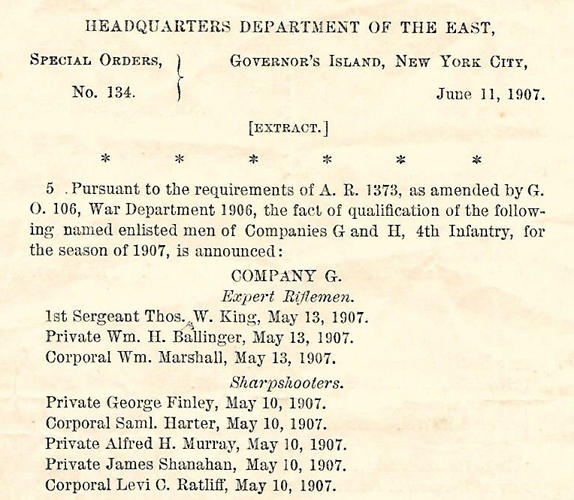
Above: A section of Special Orders 134
showing the award of a Sharpshooter qualification badge
to Private George Finley while he was in Company G 4th Infantry.
Finley's name is fifth from the bottom.
Courtesy of The Finley Family
While still in the Philippines,
on May 3, 1910, Finley was transferred with a large number of
soldiers,
from all Companies of the 4th Infantry, to units of the 9th
Infantry. He was transferred to Company I 9th Infantry.
At the end of the year he was returned to the United States and
discharged at Fort McDowell, California
on November 21, 1910 with a character reference of Excellent.
On January 5, 1911 Finley
re-enlisted at Columbus Barracks, Ohio and was assigned to
Company F 13th Infantry.
He served with his Company in Texas and was part of the Maneuver
Division exercises along the Mexican border.
He sailed with his Regiment aboard the transport U.S.A.T.
Sherman, leaving San Francisco,
California on
October 5, 1911 and arriving at Manila on October 31, 1911, for
his fourth tour of duty in the Philippines.
At some time during his service with the 13th Infantry he was
promoted to Corporal. Finley left the Philippines
in late 1913, returned to the United States, and was discharged
at Fort McDowell, California on December 22, 1913
with a character reference of Excellent.
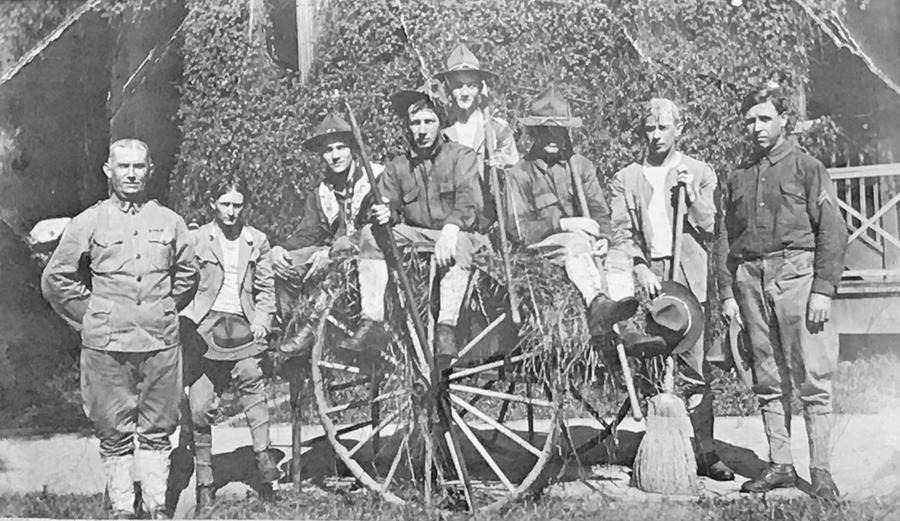
George Finley is on the
far right in the above photo. The photo is undated, however,
Finley's rank of Corporal,
and the uniforms worn by all soldiers appear to suggest this
photo was most likely taken while he was with the 13th Infantry,
during the time frame of 1911-1913.
Photo courtesy of The Finley Family
Finley re-enlisted as a Private
in Company D 3rd Infantry on January 26, 1914 and served in
Company D 3rd Infantry from
January 26, 1914 to September 2, 1917. While with the 3rd
Infantry he was promoted to Corporal on April 24, 1915,
and to 1st Sergeant on October 29, 1915. He served on Mexican
Border duty in Arizona in 1916-1917.
The 357th Infantry was created
in late August 1917 at Camp Travis, San Antonio, Texas.
Experienced cadre from the 3rd Infantry
were assigned to the 357th to constitute a nucleus of personnel,
around which the Regiment could be formed. George Finley
was one of those cadre and was assigned to Company D 357th
Infantry as its 1st Sergeant, on September 3, 1917.
The 357th Infantry was assigned
to the 90th Division, and trained at Camp Travis until it
departed overseas.
Finley and Company D, as part of 1st Battalion 357th Infantry,
sailed from Brooklyn on June 20, 1918,
aboard the troop transport Delta. The Delta developed
trouble and had to return to Halifax, Nova Scotia
for repairs, arriving there on June 25. The ship sailed from
Halifax on July 4 and reached Liverpool, England
on July 15, 1918. From England Finley and his Company were sent
over to France.
He served as 1st Sergeant of
Company D in the Villers-en-Haye Sector, the St. Mihiel
Offensive, the Puvenelle Sector,
and the Meuse-Argonne Offensive. On October 24, 1918 in the
Meuse-Argonne Offensive he was wounded by gas.
|
Left: The wound certificate issued to
George Finley Finley was wounded by gas His name, rank, and unit are marked at the bottom. Courtesy of The Finley Family |
In the Puvenelle Sector Finley
and his Company were part of a large scale raid into enemy lines
carried out on the night of
September 23, 1918. Finley captured a German anti-tank rifle
which was quite an item of interest in his Brigade.
The weapon was a Mauser Tankgewehr M1918, which fired a huge 13.2
x 92mm semi-rimmed cartridge.
1st Sergeant
George Finley, of Company "D", found an anti-tank gun
in a strong point in the second line trench just before
the Battalion was scheduled to pull back to our lines. This
anti-tank gun was shaped like an army rifle, but was about
three times the size of a rifle, and was fired from a tripod
[sic] that supported it. The Sergeant grabbbed it and several
extra rounds of its hefty ammunition and dragged it through the
German wire and the dense woods in safety to our lines.
This novel
weapon created much interest. The news of its capture spread
quickly through the regimental area.
At daylight, when the Battalion was back in the support position,
this new weapon had swarms of doughboy
callers. Numerous French artillerymen also visited it before it
was sent back to Brigade Headquarters. It was one
of the first of its type of anti-tank guns captured on this
American front, and Brigade Headquarters wanted it
at once.
After a detail
had started with the anti-tank gun back to General O'Neil's
Brigade Headquarters, a group of the officers
of the Battalion were questioning the Sergeant as to just where
he found it and how it was placed. At the end of the confab,
1st Lieutenant James V. Robins, of Company "D" said,
"Sergeant, that was playing the game in bringing back that
new toy.
I hope you get a Citation for it."
The old
Sergeant, in unmistakable Irish brogue, quickly replied,
"Hell, Lieutenant, that don't rate any Citation. They give
them
for bravery. I grabbed that damned thing up through
curiosity." 3
|
|
|||||
Mauser Tankgewehr M1918.
This is the type of weapon Photo from the Proxibid website |
German soldiers operating a
Mauser Tankgewehr M1918 Photo from the Imperial War Museum |
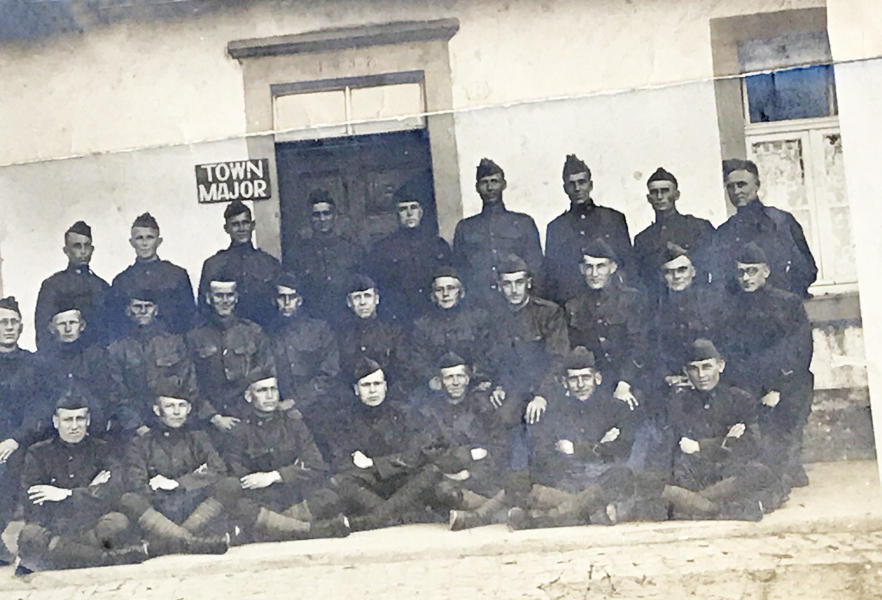
An undated photo showing George Finley
as 1st Sergeant of Company D 357th Infantry. Finley is seated in
the front row,
third from the right. The puttees on the soldiers' legs indicate
the photo was taken after the unit deployed overseas.
Courtesy of The Finley Family
Finley served on occupation duty
in Germany and returned to the United States with his Company
aboard the troop transport U.S.S. Huron, leaving St.
Nazaire, France on May 26, 1919, and arriving
at Newport News, Virginia on June 7, 1919. He was discharged on
June 10, 1919.
On September 5, 1919 George Finley became a naturalized United States citizen.
He was back on the Army rolls at
an unknown date, until his final discharge and retirement from
the Army on June 1, 1921.
His last assignment in the Army was Company M 12th Infantry at
Camp Meade, Maryland.
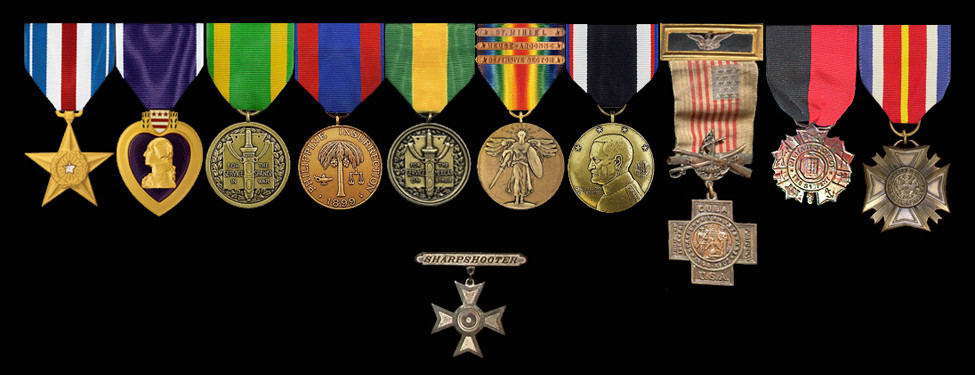
The decorations of George Finley
Top, left to right:
Silver Star, Purple
Heart, Spanish War Service Medal, Philippine Campaign Medal,
Mexican Border Service Medal,
World War I Victory Medal with clasps for St.
Mihiel/Meuse-Argonne/Defensive Sector, Army of Occupation of
Germany Medal,
United Spanish War Veterans medal, Military Order of the Serpent
medal, Veterans of Foreign Wars medal
Bottom:
Marksmanship Qualification Badge for Sharpshooter
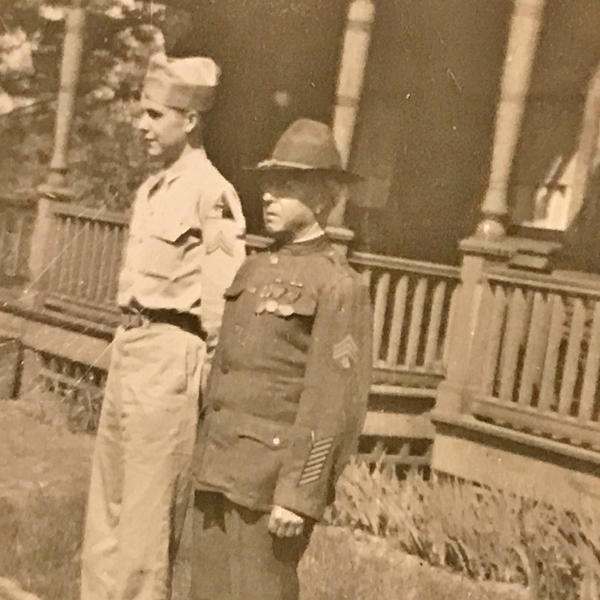
Two generations of Army soldiers
On the right: 1st
Sergeant (Retired) George A. Finley, wearing his uniform from
World War One.
His uniform shows his 1st Sergeant's stripes on his left sleeve,
and below that are service stripes
indicating 21 years of service.
On the left: Corporal George F. Finley, son of George A. Finley.
Photo taken during World War Two
Courtesy of The Finley Family
Upon retirement Finley returned
to Pittsburgh, Pennsylvania, where he married Mary Ann Schrott.
He became a bank guard
and then a surveyor's assistant. He and Mary Ann had three
children and seven grandchildren.
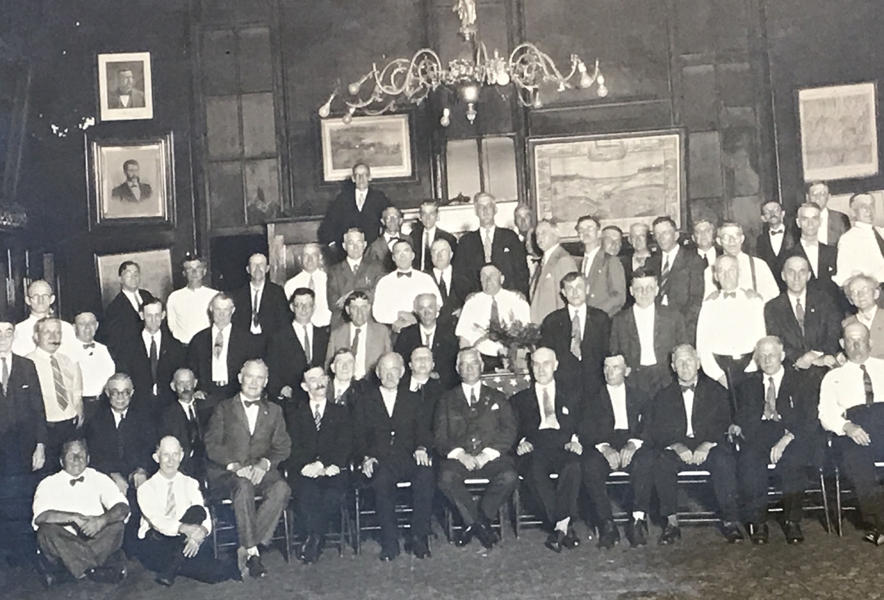
Reunion of Company D
357th Infantry in 1945. George Finley is seated in the front row,
third from the right.
The 90th Division had been holding reunions every year since the
end of World War One. Former Captain and Commanding Officer
of Company D, Beauford Jester, had been trying unsuccessfully to
get Finley to attend. Finally, in 1945, the members of
Company D all pitched in and bought Finley a round trip ticket
from Pittsburgh to Tulsa, Oklahoma, and paid for a hotel room
for him, thereby insuring their beloved 1st Sergeant would attend
this reunion.
Courtesy of The Finley Family
George A. Finley died at the age
of 73 on January 18, 1953, and is buried in Mount Royal Cemetery,
Glenshaw, Allegheny County, Pennsylvania.
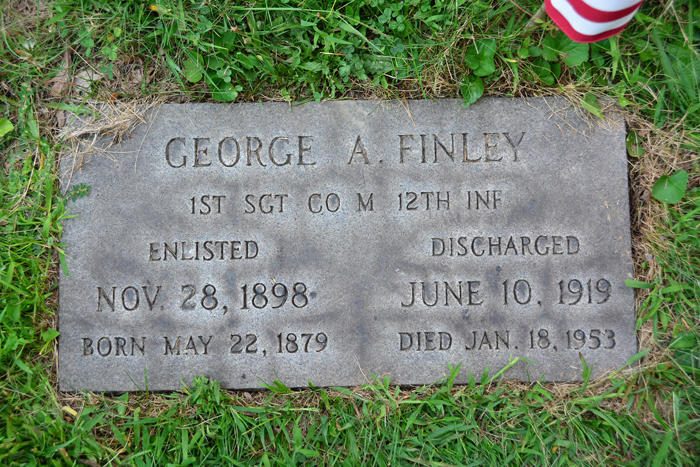
Grave marker for George A. Finley
Photo by Albertico from the Find A Grave website
1 Annual Reports of the Secretary of War, 1899, published by the United States War Department.
2 Times of Cuba and -- P.A.R. -- Pan-American Review March 1941 pp. 24-25. Author unknown. Courtesy of The Finley Family
³
Letter written by Beauford H.
Jester, former Captain and Commanding Officer of Company D 357th
Infantry, letter dated June 18, 1927. Jester wrote an article for
the
----SSan Antonio Light
newspaper about the 357th Infantry in the war, and included this
story about George Finley capturing the anti-tank gun. Courtesy
of The Finley Family.
Sources:
Register of Enlistments in the U.S. Army, 1798-1914; (National Archives Microfilm Publication M233, 81 rolls); Records of the Adjutant General’s Office, 1780’s-1917, Record Group 94; National Archives, Washington, D.C.
Returns from Regular Army Infantry Regiments, June 1821–December 1916. NARA microfilm publication M665, rolls 1–244, 262-292, 297–300 of 300. Records of the Adjutant General's Office, 1780's–1917, Record Group 94, and Records of United States Regular Army Mobile Units, 1821–1942, Record Group 391. National Archives and Records Administration, Washington, D.C.
World War I Veterans Service and Compensation File, 1934–1948. RG 19, Series 19.91. Pennsylvania Historical and Museum Commission, Harrisburg Pennsylvania.
"United States, Veterans Administration Master Index, 1917-1940," database, FamilySearch (https://familysearch.org/ark:/61903/1:1:7Y1N-F1T2 : 23 October 2019), Robert Lee Redd, ; citing Military Service, NARA microfilm publication 76193916 (St. Louis: National Archives and Records Administration, 1985), various roll numbers.
BRIEF HISTORIES OF DIVISIONS, U.S. ARMY 1917-1918 Prepared in the Historical Branch, War Plans Division, General Staff June 1921 Army Command & General Staff College, Combined Arms Research Library, Fort Leavenworth, Kansas 1921
Lists of Incoming Passengers, 1917-1938. Textual records. 360 Boxes. NAI: 6234465. Records of the Office of the Quartermaster General, 1774-1985, Record Group 92. The National Archives at College Park, Maryland.
Lists of Outgoing Passengers, 1917-1938. Textual records. 255 Boxes. NAI: 6234477. Records of the Office of the Quartermaster General, 1774-1985, Record Group 92. The National Archives at College Park, Maryland.
Google searches for history of 3rd and 4th Infantry Regiments.
The 90th Division Association website:
http://www.90thdivisionassoc.org/90thDivisionFolders/mervinbooks/WWI90/WWI90mainpage.htm
http://www.90thdivisionassoc.org/90thDivisionFolders/mervinbooks/WWI357/WWI357mainpage.htm
The website is grateful to Linda McCalmont for
sharing photos, documents, and information
about her grandfather George Finley. Considered the family
historian, Linda is be congratulated
for her passion in honoring this true American hero.
Home | Photos | Battles & History | Current |
Rosters & Reports | Medal of Honor | Killed
in Action |
Personnel Locator | Commanders | Station
List | Campaigns |
Honors | Insignia & Memorabilia | 4-42
Artillery | Taps |
What's New | Editorial | Links |